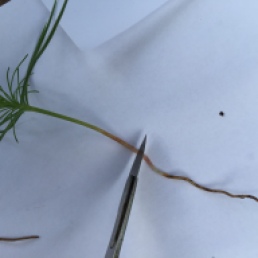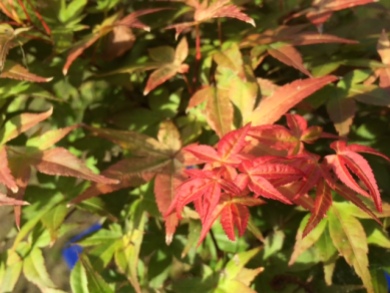I truly believe that creativity and to create is not just a mental need that all people need in their lives, but it is also a physical need. To create takes one out of your comfort zone and puts you in places where you have not been before. My choice of Art that I use to feed my creative spirit is Bonsai creation. I will be the first to admit that I probably spend a lot more time on the husbandry, maintenance and redesign of Bonsai than what I do creating Bonsai, but that is part and parcel of what we do as Bonsai artists. One of the main reasons why I am involved in this Art form is that it is never complete. You are constantly searching, asking questions and probing for your creation to become a master piece. Does that ever happen? I have not seen it in my own work yet, but have so in others and I am driven to get my own artwork to that level.
To explore Creativity as a study area, means that I read a lot and get trapped into conversations about what creativity is, how we can develop our own creativity and the creativity in others (that is the educationist in me). I spend a lot of time with creative people and I also do believe that it rubs off on other people mainly due to the passion that is shared when creative get in contact with each other. It can be a very solitary pursuit and aloneness and mindfulness is important in the pursuit of higher levels of creativity, but I also do believe that it is a social activity. It needs to be shared and shown.
A good definition that I have encountered on this path of creativity that I have walked,  crawled and sprinted on, comes from Doreen Marcial Paraba in her book “Unlocking your Creativity” (2015) where she states that “Creativity is initiating, activating, and complementing ideas that are original, unusual, useful, or innovative. The ideas may advance an existing concept or seemingly spring forth from nowhere”.
crawled and sprinted on, comes from Doreen Marcial Paraba in her book “Unlocking your Creativity” (2015) where she states that “Creativity is initiating, activating, and complementing ideas that are original, unusual, useful, or innovative. The ideas may advance an existing concept or seemingly spring forth from nowhere”.

From this one can deduct that the end product should be useful and be put into action (a concept that the above mentioned author agrees with). Can that be applied to Bonsai? Most definitely it can! We start a tree from either a seedling, a cutting or raw material. We therefore activate the idea that we have and apply it to the tree. Real creativity is when we are original. In Bonsai there are “rules”, first started off by Chinese Bonsai practitioners and then taken further by Japanese artists. Out of these eras came many rules and conventions that should be applied to Bonsai for it to be Bonsai in its art form. Do these rules restrict us in our thinking? No, it does not. It serves merely as a guideline, a foundation to work from. These “rules” did come from a deeply ingrained sense of Art applied to plants and therefore is legitimate (based on history) in the world of Art and Creativity. Most art forms do have a history and a foundation level of skills and knowledge. We see the same in Bonsai, making it a legitimate art form.
Can we be innovative? The above mentioned definition emphasises originality and uses the words, unusual and innovative. This is not restricted to the Literati style of Bonsai. Every tree has different growing conditions, trunk shapes, branch structures and foliage patterns. Even trees within the same species show different characteristics. Just as one artist can paint many different paintings, Bonsai artists can design and create many different forms of trees either within one species or across many different species.
A lot of people that I encounter, do not think that they are particularly talented when it
comes to creativity. When asked whether they have explored it, the answer is usually negative, followed by a whole lot of different reasons of why it is not happening for them. It is interesting that out of these conversations a large proportion of people identify that they cannot remember them ever being creative and except for early drawings and fooling around with paint, this aspect of their lives were just never explored or developed. Many literature sources that I have encountered ask the question “Is Creativity Learnable or Teachable?”. The answers range from “it is in our nature to be creative” to “we use our imaginations all the time” to “”creativity skills are learnable with training”.
This training can take many different forms. I learnt first through exposure to watching my father work with his Bonsai, to helping him with some tasks, to starting my own Bonsai and later reading profusely and learning from other more advanced artists. We know that Bonsai professionals usually undergo a long apprenticeship period, but these days learning can take place wherever, whenever and at the pace of the learner. Advances in technology have made this possible and it is possible that one can advance to a very high level of understanding and expertise without having to go through a lengthy apprenticeship. I still do believe that some form of exposure to good technique, skill and understanding is important for one to advance your own level of artistry and creativity.
 You will probably not develop a very high skill level by just reading or just watching other people engaged in the practice of Bonsai. Learning is an active process. You need practice, you need to do and you need to get feedback to enable you to learn. Another great way of learning is when you start to share your knowledge and skill with others. In other words, teaching. Learning is a very interesting area of science. It is all about establishing neural pathways within your nervous system. The more you do something or interact with it, the easier data flows along these pathways and it can become an automatic response. Can you imagine how hard it will be if you have practiced the wrong technique over and over again and then have to unlearn it to enable you to learn the correct one. This is another reason why we do need exposure to others to establish these neural networks. Learning is also a social practice.
You will probably not develop a very high skill level by just reading or just watching other people engaged in the practice of Bonsai. Learning is an active process. You need practice, you need to do and you need to get feedback to enable you to learn. Another great way of learning is when you start to share your knowledge and skill with others. In other words, teaching. Learning is a very interesting area of science. It is all about establishing neural pathways within your nervous system. The more you do something or interact with it, the easier data flows along these pathways and it can become an automatic response. Can you imagine how hard it will be if you have practiced the wrong technique over and over again and then have to unlearn it to enable you to learn the correct one. This is another reason why we do need exposure to others to establish these neural networks. Learning is also a social practice.
In summary then. We are all creative, we all need an outlet for our creative spirit, Bonsai can provide that outlet and we can all learn to become more creative and to express this in Bonsai as an art form.
Applications:
- Read profusely.

- Watch many videos.
- Get to know the foundations and rules of Bonsai (only to bend them later).
- Join a club.
- Visit and talk to other Bonsai artists.
- Create and maintain your own Bonsai.
References
Poreba, D.M. (2015) Unlocking your Creativity. New York: Penquin Random House (Alpha Books). 318p.
Fisher, D. & Frey, N. (2013) Better learning through structured teaching. Vancouver (USA): ASCD Press. 158p.
 the germination of Pine seedlings. These seeds (planted on 26 January 2016) germinated very fast and are now large enough to change into cuttings. The reason why I do this is that it gets rid of the tap root early on and forces the seedling to grow new roots and the hope is that the new roots will develop radially for a really great nebari. That is theory.
the germination of Pine seedlings. These seeds (planted on 26 January 2016) germinated very fast and are now large enough to change into cuttings. The reason why I do this is that it gets rid of the tap root early on and forces the seedling to grow new roots and the hope is that the new roots will develop radially for a really great nebari. That is theory.











 crawled and sprinted on, comes from Doreen Marcial Paraba in her book “Unlocking your Creativity” (2015) where she states that “Creativity is initiating, activating, and complementing ideas that are original, unusual, useful, or innovative. The ideas may advance an existing concept or seemingly spring forth from nowhere”.
crawled and sprinted on, comes from Doreen Marcial Paraba in her book “Unlocking your Creativity” (2015) where she states that “Creativity is initiating, activating, and complementing ideas that are original, unusual, useful, or innovative. The ideas may advance an existing concept or seemingly spring forth from nowhere”.




 You will probably not develop a very high skill level by just reading or just watching other people engaged in the practice of Bonsai. Learning is an active process. You need practice, you need to do and you need to get feedback to enable you to learn. Another great way of learning is when you start to share your knowledge and skill with others. In other words, teaching. Learning is a very interesting area of science. It is all about establishing neural pathways within your nervous system. The more you do something or interact with it, the easier data flows along these pathways and it can become an automatic response. Can you imagine how hard it will be if you have practiced the wrong technique over and over again and then have to unlearn it to enable you to learn the correct one. This is another reason why we do need exposure to others to establish these neural networks. Learning is also a social practice.
You will probably not develop a very high skill level by just reading or just watching other people engaged in the practice of Bonsai. Learning is an active process. You need practice, you need to do and you need to get feedback to enable you to learn. Another great way of learning is when you start to share your knowledge and skill with others. In other words, teaching. Learning is a very interesting area of science. It is all about establishing neural pathways within your nervous system. The more you do something or interact with it, the easier data flows along these pathways and it can become an automatic response. Can you imagine how hard it will be if you have practiced the wrong technique over and over again and then have to unlearn it to enable you to learn the correct one. This is another reason why we do need exposure to others to establish these neural networks. Learning is also a social practice.